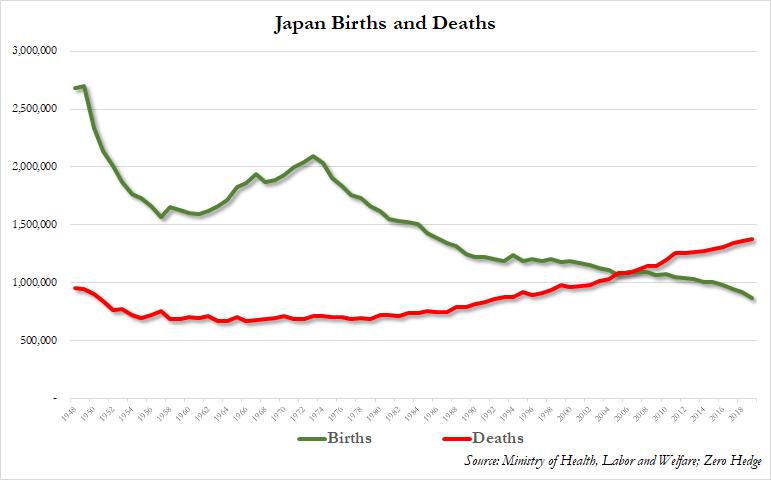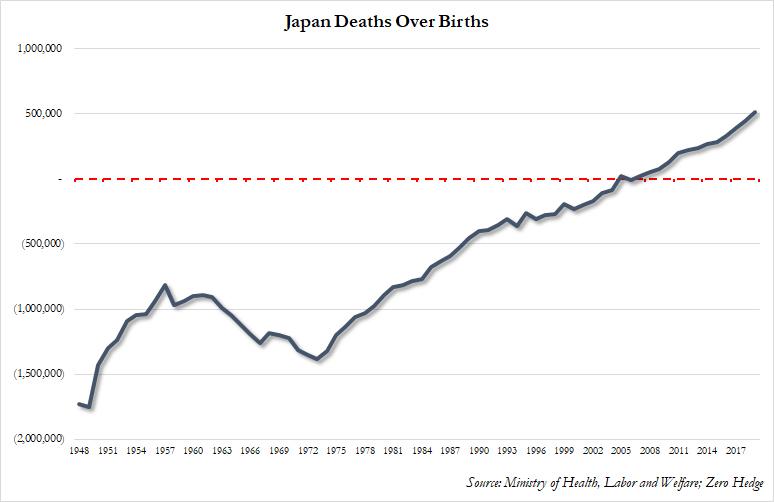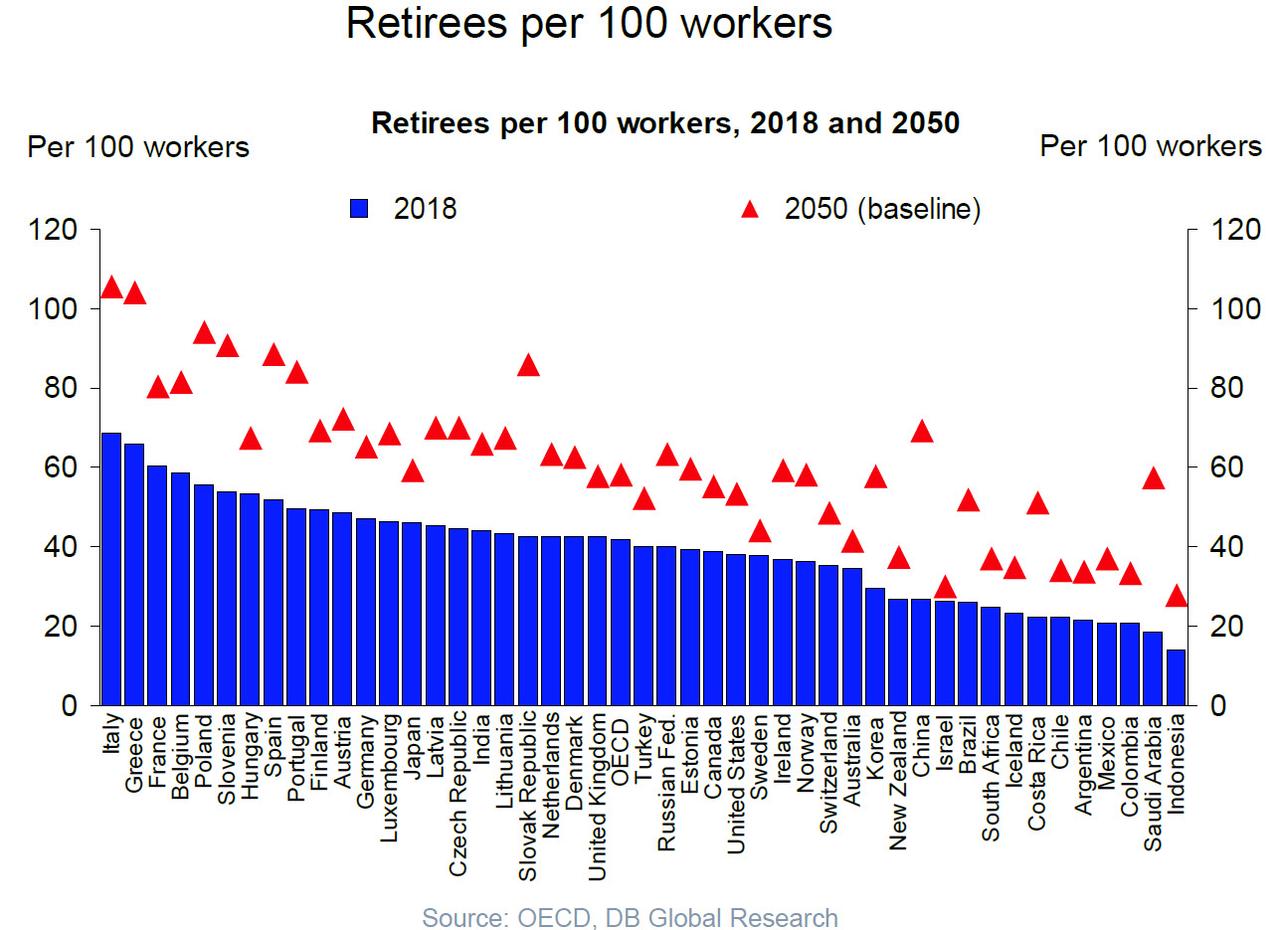Demographic Armageddon: Japan’s Births Drop To Lowest Since 1874 As Deaths Hit Highest Since World War II
Japan’s demographic Armageddon made another entry in the history books this week when Japan’s welfare ministry estimated that in 2019, Japan’s population organically shrank by 512,000 people this year compared to 2018. That’s a drop of more than the entire population of the city of Atlanta.
While Japan’s demographic doom is well-known, its severity has taken on a breathless haste in recent years with births in the country — which are expected to drop below 900,000 this year — are at their lowest figure since 1874 according to the NYT, when the population was about 70% smaller than its current 124 million.
Meanwhile, as Japan’s birthrate collapses, the total number of deaths is accelerating with every passing year, and in 2019 the figure is expected to reach almost 1.4 million, 60% more than the number of births, and the highest level since the end of World War II, a rise driven by the country’s increasingly elderly population.
That gap between births and deaths, which has risen above half a million for the first time ever, has put Japan on the path to demographic destruction and deflationary doom, because in a country that shrinks by over half a million people each year, economic concepts such as resource scarcity become increasingly quaint.
Indeed, as the number of births goes down, there are fewer young people entering its work force. That means fewer people to replace retiring workers and support them as they age, a situation that poses a serious threat to Japan’s economic vitality and the security of its social safety net – although, as we noted previously, Japan is not even in the Top 10 list of nations with the heaviest retiree burden; that group is headed by Italy, Greece and France.
Japan is not the only country having to cope with a shrinking society. It’s not even the country with the lowest birthrate: That title, according to the NYT, goes to South Korea. Meanwhile, other countries — including China and the United States — also face declining birthrates, which could spell demographic trouble down the road.
But Japan stands out in one specific way: it is the world’s grayest nation, with almost 28% of its residents over the age of 65.
Japan reached it demographic tipping point over a decade ago, giving Tokyo ample opportunity to find a solution and address the effects of its declining population. The country has been consistently shrinking since 2007, when the country’s population dipped by around 18,000 people. Since then, however, the losses have accelerated, crossing the half-million mark this year for the first time. Across the nation, whole villages are vanishing as young people choose not to have children or move to urban areas in search of better employment opportunities (or they just happen to be close to the Fukushima radioactive wasteland).
Unfortunately for Japan, it’s only going to get worse as there is no end to the decline in sight. The government estimates that the population could shrink by around 16 million people, nearly 13%, over the next 25 years.
In seeking to stave off demographic armageddon, Japan has made efforts to push up its fertility rate defined as the average number of births per woman, from its current level of around 1.4 to a target of 1.8, although still short of the 2.1 considered necessary to hold the population steady. The government has moved to encourage births by increasing incentives for parents to have more children and reducing obstacles that might discourage those who want to.
But like every other failed attempt by the state or economists to dictate behavior, the incentives have proved woefully insufficient as more people in Japan are putting off childbirth — or not having children at all — either to take advantage of economic opportunities or because they worry that economic opportunities do not exist and feel that they cannot afford children. Even for those who do want to be parents, the hurdles remain daunting.
Demand for day care in the country far outstrips supply, making it difficult for working women to juggle careers and children. Meanwhile, working men who want to take advantage of the country’s generous paternity leave can find themselves stigmatized by an entrenched cultural belief that a man’s place is in the office, not in the home.
If this wasn’t enough, the NYT also notes that adding to the government’s worries, marriage is also on the decline. The number of marriages dropped by 3,000 year-on-year to 583,000, according to the data released on Tuesday, part of a steep decline over the last decade.
Ironically, the most practical solution, if only from a labor standpoint, is also a terminal one for Japan as a society: as births continue to drop, Japan has tried to promote robots as a supplement for its shrinking work force. The only problem: robots don’t vote, don’t pay taxes, and don’t have little robot children of their own.
Finally, in an attempt to succeed where Germany, and Merkel’s “Open Door” policies failed, Japan has also committed to accepting limited numbers of immigrants to handle vital work such as caring for the elderly. This year the country began issuing more than a quarter-million visas to immigrants who will do such work. The only problem: the Japanese are notorious nationalists and tend to ostracize, mock and ridicule and gai jin to the point where nobody actually wants to stay in the notoriously closed-off society.
Tyler Durden
Fri, 12/27/2019 – 18:45
via ZeroHedge News https://ift.tt/351C2tG Tyler Durden


